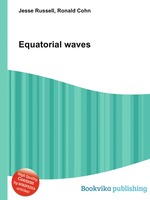Equatorial waves
Jesse Russell Ronald Cohn
бумажная книга
High Quality Content by WIKIPEDIA articles! Equatorial waves are waves trapped close to the equator, meaning that they decay rapidly away from the equator, but can propagate in the longitudinal and vertical directions. Wave trapping is the result of the Earth`s rotation and its spherical shape which combine to cause the magnitude of the Coriolis Force to increase rapidly away from the Equator. Equatorial Waves are present in both the tropical atmosphere and ocean and play an important role in the evolution of many climate phenomena such as El Nino. Many physical processes may excite equatorial waves including, in the case of the atmosphere, diabatic heat release associated with cloud formation, and in the case of the ocean, anomalous changes in the strength or direction of the trade winds. Equatorial waves may be separated into a series of sub-classes depending on their fundamental dynamics (which also influences their typical periods and speeds and directions of propagation). At shortest periods are the equatorial gravity waves while the longest periods are associated with the equatorial Rossby waves. In addition to these two extreme sub-classes, there are two special sub-classes of equatorial waves known as the mixed Rossby-gravity wave (also known as the Yanai wave) and the equatorial Kelvin Wave. The latter two share the characteristics that they can have any period and also that they may carry energy only in an eastward (never westward) direction. The remainder of this article discusses the relationship between the period of these waves, their wavelength in the zonal direction and their speeds for a simplified ocean.


